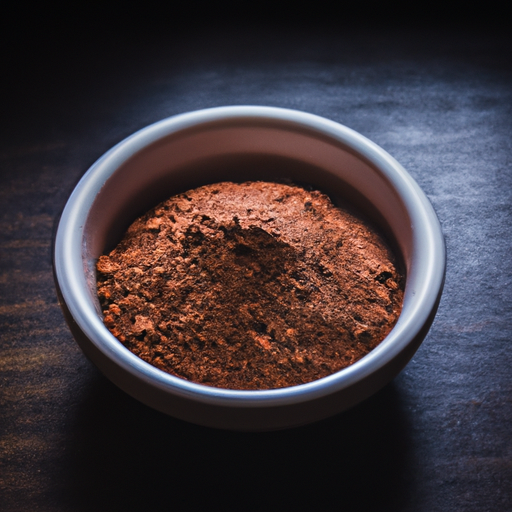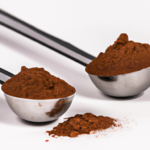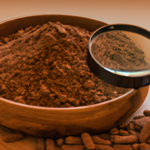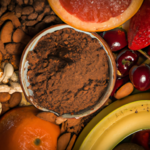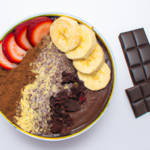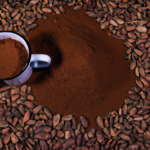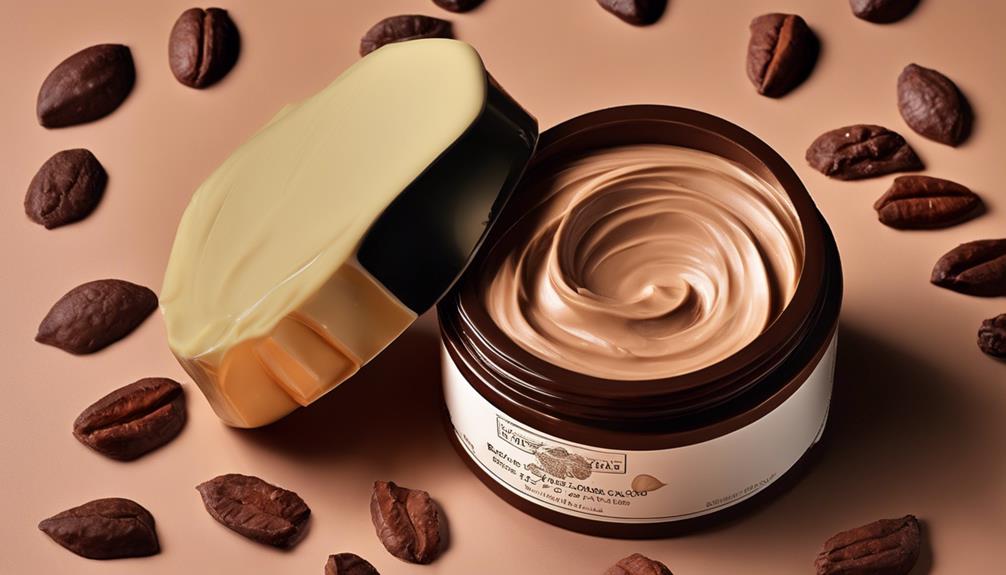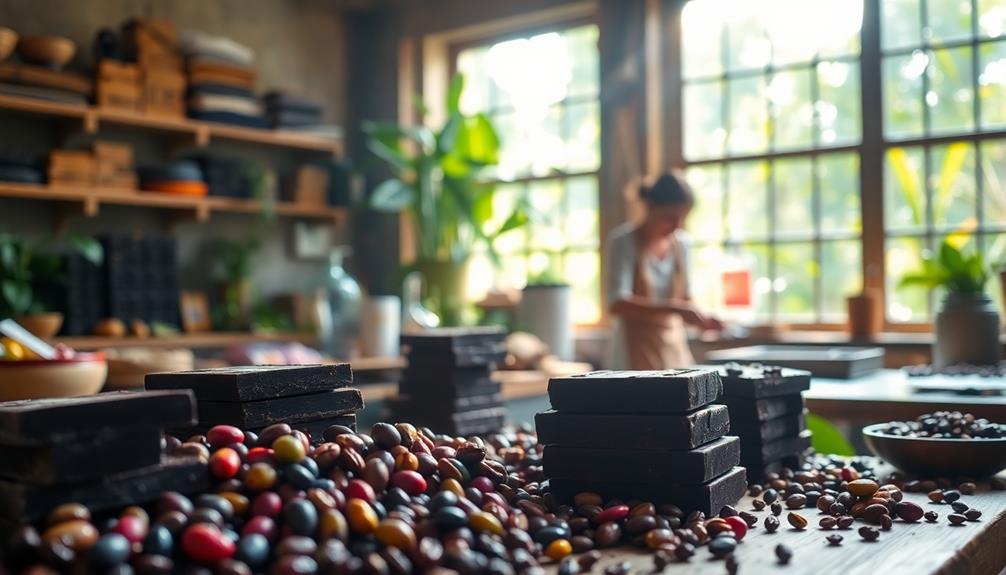Have you ever thought about how much raw cacao powder is safe to consume in a day? Well, I have some good news for you. In this article, we will discuss the health benefits of raw cacao powder, the recommended daily intake, and potential risks of consuming too much.
I’ll also share some delicious ways to incorporate this superfood into your diet and tips for choosing high-quality raw cacao powder.
But before we dive in, let me paint a picture for you. Imagine indulging in a rich, velvety cup of hot chocolate that not only satisfies your sweet tooth but also provides a boost of antioxidants and other beneficial nutrients. Sounds tempting, right?
Well, that’s just one of the many ways you can enjoy raw cacao powder. So, let’s get started and discover how to make the most of this delightful ingredient while keeping our health in check.
Key Takeaways
- Recommended serving size of raw cacao powder is 1 to 2 tablespoons per day
- Enjoy raw cacao powder in moderation to avoid side effects
- Be mindful of caffeine intake, as cacao powder contains caffeine and theobromine
- Consult a healthcare professional before making dietary changes with cacao powder
The Health Benefits of Raw Cacao Powder
Raw cacao powder offers a myriad of health benefits that make it a deliciously nutritious addition to your daily routine.
Studies have shown that raw cacao powder is packed with antioxidants, which can help protect against cell damage and reduce the risk of chronic diseases such as heart disease and cancer.
Additionally, it contains flavanols, which have been linked to improved brain function and a reduced risk of age-related cognitive decline.
However, it is important to consume raw cacao powder in moderation. While there is no official recommended daily intake, experts suggest consuming no more than 1-2 tablespoons per day.
Consuming excessive amounts of raw cacao powder may lead to potential health risks such as increased heart rate, digestive issues, and mineral imbalances.
Therefore, it is important to enjoy raw cacao powder in moderation for optimal health benefits.
Recommended Daily Intake of Raw Cacao Powder
Determining your personal needs and tolerance when it comes to consuming raw cacao powder is essential. Everyone’s body is different, and what works for one person may not work for another. It’s important to listen to your body and make adjustments accordingly.
Moderation is key when it comes to incorporating raw cacao powder into your daily routine. While it does have health benefits, consuming too much can lead to negative effects. It’s important to find the right balance for you.
Determining Your Personal Needs and Tolerance
Determining your personal needs and tolerance for cacao powder is an important step in incorporating it into your daily routine. Personal preferences play a big role in deciding how much cacao powder to include in your diet. Some people may prefer a stronger cacao flavor and choose to consume more, while others may prefer a milder taste and consume less.
It’s also crucial to consider the health benefits of cacao powder, such as its high antioxidant content and potential mood-boosting effects. However, it’s essential to listen to your body and monitor any potential side effects. Consuming too much cacao powder can lead to digestive issues or caffeine sensitivity.
Moderation is key when it comes to incorporating cacao powder into your daily routine. Finding a balance that works for you is important. So, take the time to experiment and adjust the amount of cacao powder based on your personal needs and tolerance.
Moderation is Key
Be careful not to go overboard with your newfound love for cacao, or you might find yourself feeling less than satisfied with the consequences.
It’s important to remember that moderation is key when it comes to consuming raw cacao powder. While cacao does offer a range of health benefits, including antioxidants and mood-enhancing properties, it’s still important to consider your personal preferences and tolerance.
Some individuals may find that they can tolerate larger amounts of cacao without any negative effects, while others may experience digestive issues or caffeine sensitivity with even small amounts. If you’re unsure about your tolerance, it’s best to start with small doses and gradually increase as needed.
Additionally, there are alternative options to consider if you’re concerned about consuming too much raw cacao powder, such as using cacao nibs or opting for lower cacao content products.
Transitioning into the next section, it’s important to be aware of the potential risks of consuming too much raw cacao powder.
Potential Risks of Consuming Too Much Raw Cacao Powder
Consuming too much raw cacao powder can have potential risks. Its high calorie and fat content can lead to weight gain and an increased risk of health issues associated with a high-fat diet.
In addition, raw cacao powder contains stimulants like caffeine and theobromine. These stimulants can cause digestive issues and may not be suitable for individuals who are sensitive to them.
It is important to be mindful of the recommended daily intake and consider these potential risks when incorporating raw cacao powder into your diet.
High in Calories and Fat
Indulge in the rich and decadent flavor of raw cacao powder without worrying about its high calorie and fat content.
While raw cacao powder is indeed high in calories and fat, it is important to consider its overall nutritional value and potential health benefits.
Raw cacao powder is packed with essential minerals like magnesium, iron, and zinc, which are beneficial for our overall health. Additionally, it is a great source of antioxidants that can help protect our cells from damage caused by free radicals.
However, it is crucial to consume raw cacao powder in moderation as excessive intake can lead to weight gain and an increased risk of certain health issues.
Transitioning into the subsequent section, it is important to note that consuming too much raw cacao powder may cause digestive issues.
May Cause Digestive Issues
After discussing the high calorie and fat content of raw cacao powder, it’s important to delve into the potential digestive issues that may arise from consuming it.
While raw cacao powder is generally safe for most people, some individuals may experience side effects such as bloating, gas, or diarrhea. These digestive issues can occur due to the high fiber content present in cacao powder, which may not be well-tolerated by everyone.
If you notice any discomfort or digestive disturbances after consuming raw cacao powder, it’s advisable to reduce your intake or consult with a healthcare professional.
Moving forward, it’s essential to explore another aspect of raw cacao powder: its stimulating properties. Raw cacao powder contains natural stimulants like caffeine and theobromine, which can have various effects on the body.
Contains Stimulants like Caffeine and Theobromine
With its energizing properties, raw cacao powder can be likened to a vibrant sunrise, awakening the senses and invigorating the body. This natural ingredient contains stimulants like caffeine and theobromine, which contribute to its stimulating effects.
Caffeine, a well-known stimulant, can enhance alertness and focus, while theobromine provides a gentle lift without the jitters associated with caffeine.
However, it is important to note that the caffeine content in raw cacao powder is significantly lower than in coffee or tea. Moderate consumption of raw cacao powder is generally safe for most individuals, but excessive intake can lead to side effects such as restlessness or insomnia. As with any food or beverage, it’s always best to listen to your body and consume in moderation.
Transitioning into the subsequent section about ways to incorporate raw cacao powder into your diet, there are various delicious recipes and creative ideas to explore.
Ways to Incorporate Raw Cacao Powder into Your Diet
When it comes to incorporating raw cacao powder into my diet, I have found three key ways that work well for me.
First, I love adding it to my smoothies and shakes for a rich and chocolatey flavor.
Secondly, baking and desserts become even more decadent with a sprinkle of raw cacao powder.
And lastly, on those cold winter nights, a warm cup of hot chocolate made with raw cacao powder is the perfect treat.
These versatile options allow me to enjoy the benefits of raw cacao powder in a variety of delicious ways.
Smoothies and Shakes
Indulge in a rich and creamy smoothie, blended with raw cacao powder for a decadent treat. Adding raw cacao powder to your smoothies or protein shakes not only enhances the flavor, but also provides numerous health benefits. Here are three reasons why you should consider incorporating this delicious ingredient into your drinks:
-
Boosts mood and energy: Raw cacao powder contains natural compounds like theobromine and phenylethylamine, which can help improve mood and increase energy levels.
-
Rich in antioxidants: Cacao powder is packed with antioxidants that fight against free radicals, reducing inflammation and supporting overall health.
-
Enhances cardiovascular health: Studies have shown that the flavonoids in raw cacao powder can help improve blood flow, lower blood pressure, and reduce the risk of heart disease.
Now, let’s move on to the next section about baking and desserts, where you can explore more ways to enjoy the goodness of raw cacao powder.
Baking and Desserts
Get ready to satisfy your sweet tooth with the deliciousness of raw cacao powder in a variety of indulgent baked goods and desserts! Baking with raw cacao powder is not only a great way to add a rich chocolate flavor to your treats, but it also provides numerous health benefits. When using raw cacao powder in your baking, there are a few tips to keep in mind. First, make sure to sift the powder to remove any lumps and ensure a smooth texture. Second, reduce the amount of sugar in your recipe, as raw cacao powder has a natural sweetness. Lastly, experiment with healthy alternatives like coconut oil or almond milk to add a nutritious twist to your desserts. With these baking tips, you can create delectable treats that are both indulgent and good for you. Now, let’s move on to the next section and explore how to incorporate raw cacao powder into hot chocolate and beverages.
Hot Chocolate and Beverages
When it comes to indulging in something warm and comforting, hot chocolate is always a go-to for me. But did you know that you can make delicious hot chocolate recipes using raw cacao powder? Not only does it add a rich and decadent flavor, but it also comes with numerous health benefits.
Here are a few of my favorite hot chocolate recipes that incorporate raw cacao powder:
- Classic Hot Chocolate: A simple and timeless recipe that brings back childhood memories.
- Spiced Cacao Latte: Perfect for those chilly winter nights, this recipe adds a hint of warmth with spices like cinnamon and nutmeg.
- Mint Cacao Hot Chocolate: A refreshing twist on the classic recipe, the cool mint flavor pairs perfectly with the richness of cacao.
- Vegan Cacao Smoothie: For a healthier alternative, blend raw cacao powder with almond milk, banana, and a touch of honey.
Now that we know how versatile raw cacao powder can be in creating delicious and comforting beverages, let’s move on to the next step: choosing high-quality raw cacao powder.
Choosing High-Quality Raw Cacao Powder
When choosing high-quality raw cacao powder, it’s important to consider both taste and nutritional value. Opt for organic cacao powder to avoid harmful pesticides and chemicals. Organic varieties often have a richer flavor and higher concentration of antioxidants. Raw cacao powder has also been linked to various skin benefits, including improved hydration, reduced inflammation, and a more youthful appearance. However, individual results may vary, so consulting with a healthcare professional before making major dietary changes is always a good idea. They can offer personalized advice based on your specific health needs.
Consulting with a Healthcare Professional
Consulting with a healthcare professional can provide valuable guidance and personalized advice regarding the incorporation of high-quality organic cacao powder into your daily routine. Healthcare professionals are trained to assess individual health needs and can make recommendations based on your specific circumstances. They can help determine the appropriate amount of cacao powder for you, taking into consideration factors such as your overall health, dietary restrictions, and any potential allergic reactions.
It is important to consult with a healthcare professional because they can help you understand how much cacao powder is safe and beneficial for you. They can also inform you about any potential allergic reactions or interactions with medications. By seeking their expert advice, you can ensure that you are harnessing the benefits of cacao powder in a way that supports your overall well-being.
Moving forward, it is important to consider other factors, such as sourcing, processing methods, and potential contaminants, when choosing a high-quality cacao powder.
Other Factors to Consider
To fully savor the benefits of organic cacao powder, it’s worth exploring factors like sourcing, processing methods, and potential contaminants that can add depth to your cacao experience.
When considering factors affecting absorption, it’s important to note that cacao powder contains compounds like polyphenols and flavonoids that can enhance its bioavailability. However, certain factors such as the presence of milk or dairy products in your diet can reduce the absorption of these beneficial compounds.
Additionally, potential interactions with medications should be taken into account. Some medications, like MAO inhibitors, can interact with the compounds found in cacao powder and may cause adverse effects. Therefore, consulting with a healthcare professional is crucial, especially if you are taking any medications.
Understanding these factors can help you make informed decisions about incorporating cacao powder into your diet.
Transitioning into the next section about experimenting with raw cacao powder recipes, it’s important to explore the versatility of this ingredient.
Experimenting with Raw Cacao Powder Recipes
Let’s dive into the world of raw cacao powder by exploring creative and delicious recipes that will delight your taste buds. One way to experiment with savory dishes is to add a sprinkle of raw cacao powder to your favorite chili or mole sauce. The rich, earthy flavor of cacao can add depth and complexity to these dishes, creating a unique and satisfying experience. Another way to incorporate cacao powder is by using it in beauty products. Cacao powder contains antioxidants that can help nourish and protect your skin. You can create a homemade face mask by mixing cacao powder with honey and yogurt, leaving your skin feeling refreshed and rejuvenated. Remember, moderation is key when enjoying raw cacao powder. Too much can lead to unwanted side effects. Transitioning into the next section, let’s explore the importance of enjoying raw cacao powder in moderation.
Conclusion: Enjoying Raw Cacao Powder in Moderation
Indulge in the luscious taste of raw cacao powder, but remember to savor it in moderation, like a tantalizing bite of decadent chocolate that leaves you craving for more. When it comes to enjoying this delicious ingredient, the key is to find the right balance.
Recommended serving: A typical serving size of raw cacao powder is around 1 to 2 tablespoons per day. This amount provides a good balance of flavor and health benefits without going overboard.
Potential side effects: While raw cacao powder is generally safe to consume, it does contain caffeine and theobromine, which can have stimulating effects. It’s important to be mindful of your caffeine intake, especially if you’re sensitive to its effects.
Listen to your body: As with any food, it’s essential to pay attention to how your body reacts. If you notice any adverse effects like jitteriness or digestive issues, it may be a sign that you’re consuming too much.
By enjoying raw cacao powder in moderation and being mindful of your body’s response, you can savor its rich flavor and potential health benefits without overindulging.
Frequently Asked Questions
Can raw cacao powder help with weight loss?
Raw cacao powder may support weight loss by boosting metabolism and aiding in appetite control. However, it’s important to note that the amount needed for these effects may vary. Consult a healthcare professional for personalized advice.
Can raw cacao powder improve mood and reduce stress?
Raw cacao powder can positively impact mental health by enhancing mood and reducing stress. It also supports cognitive function. Incorporating raw cacao powder into your daily routine can be a natural and delicious way to promote overall well-being.
Does raw cacao powder have any effect on blood pressure?
Raw cacao powder can have positive effects on heart health and cholesterol levels. Research suggests that it may help lower blood pressure, but an optimal daily amount has not been established.
Can raw cacao powder be beneficial for athletes and fitness enthusiasts?
Raw cacao powder can be beneficial for athletes and fitness enthusiasts. It has been shown to enhance muscle recovery and improve athletic performance. Incorporating raw cacao powder into your diet can provide these benefits.
Is raw cacao powder safe to consume during pregnancy and breastfeeding?
Raw cacao powder is generally safe to consume during pregnancy and breastfeeding. It can support hormonal balance and promote digestive health. However, it’s important to check with a healthcare professional for individualized advice.
Is There a Recommended Daily Limit for Raw Cacao Consumption?
Raw cacao daily consumption should be limited to avoid potential side effects. While there is no established recommended daily limit, experts suggest consuming no more than 1-2 ounces of raw cacao per day to minimize the risk of negative health effects. Always consult with a healthcare professional for personalized guidance.
Conclusion
In conclusion, incorporating raw cacao powder into your diet can provide numerous health benefits. However, it is important to consume it in moderation.
As a guideline, experts recommend consuming no more than 1 to 2 tablespoons of raw cacao powder per day. Interestingly, studies have shown that consuming small amounts of raw cacao powder can help improve mood and reduce inflammation due to its high antioxidant content.
Remember to consult with a healthcare professional and choose high-quality raw cacao powder to maximize its benefits. Enjoy experimenting with raw cacao powder recipes and savor the goodness it adds to your daily routine.

